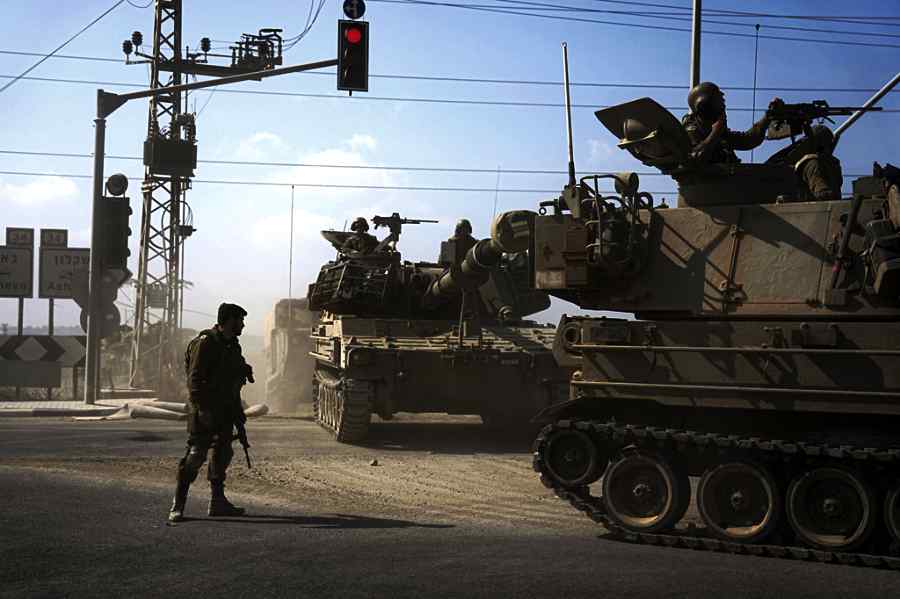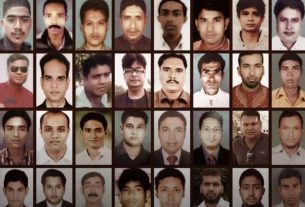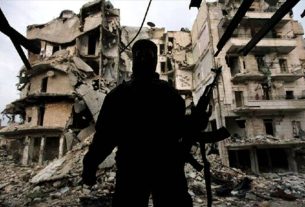Fri 03 October 2023:
The controversial policy to avoid the capture of Israeli soldiers isn’t formally in place now. But echoes persist in the war in Gaza, say some analysts.
Yehuda Shaul describes his three years of service with the Israeli military, from 2001 to 2004, as the “most violent period” of the Israeli-Palestinian conflict up to that point.
The second Intifada (2000-2005), or Palestinian uprising, was at its crescendo and then-18-year-old Shaul was an infantry combat soldier; later, he was promoted to commander. The Jerusalem born and bred paratrooper served in the occupied West Bank for two years, and for a third year was stationed at Israel’s border with Lebanon.
Now 41, Shaul is a co-founder of the Israeli NGO Breaking the Silence, the first such organisation of Israeli military veterans calling for an end to the Israeli occupation of the West Bank, East Jerusalem and the Gaza Strip.
It was during his time stationed at the border with Lebanon that Shaul was first told about the Hannibal Directive, a former controversial Israeli military policy aimed at preventing the capture of Israeli soldiers by enemy forces – at any cost.
Israel last invoked it in 2014 during the war on Gaza that year, according to leaked military audio recordings, though the army denied it had used the doctrine. Dozens of Palestinians were killed in the Israeli bombardment that followed, sparking accusations of war crimes against the Israeli army.
But to Shaul, the Hannibal Directive made sense as a soldier of war.
So what exactly is it? And is the directive – which Israel is believed to have suspended in 2016 – relevant to Israel’s current bombardment of Gaza that has killed more than 9,000 people? The bombing followed the October 7 attack by Hamas on southern Israel in which more than 1,400 people were killed and at least 200 Israelis – including soldiers and civilians – were taken captive.
What is the Hannibal Directive?
The directive, also known as the Hannibal Procedure or Hannibal Protocol, is an Israeli military policy that stipulates the use of maximum force in the event of a soldier being kidnapped, said Shaul.
“You will open fire without constraints, in order to prevent the abduction,” he said, adding that the use of force is carried out even at the risk of killing a captive soldier.
In addition to firing at the abductors, soldiers can fire at junctions, roads, highways and other pathways opponents may take a kidnapped soldier through, Shaul said.
The Israeli military has denied the interpretation of the directive that allows for the killing of their fellow troops, but Israeli soldiers, including Shaul, have understood it as a licence to do just that, as it is preferred to a scenario in which a soldier is taken prisoner.
Shaul said that the directive was shared with him and other commanders orally. “I’ve never seen any written text of the rules of engagement,” he said.
According to Annyssa Bellal, an international lawyer who specialises in armed conflicts and international law, and senior researcher at the Geneva Graduate Institute, the directive was never an official policy and was therefore never published in its entirety.
“From a legal point of view, the directive is very controversial,” Bellal told Al Jazeera.
The aspect of the directive which risks killing a soldier is controversial under international law given that states must respect their citizens’ right to life, which is not a right lost even if they are captured by other states, she explained.
Where does it get its name?
The origins of the directive’s name are disputed, with some sources saying it is named after a Carthaginian general who chose to poison himself instead of falling captive to the Romans in 181 BC.
Israeli military officials, however, have said that a computer randomly generated the name.
Why was the directive created?
In 1986, Israeli army commanders drew up the doctrine after three soldiers from the Givati Brigade, an Israeli infantry brigade, were captured by the armed Lebanese group Hezbollah.
At that time, Israel occupied a southern region of the Levantine country in an area it created and called a security zone after its invasion of Lebanon in 1982. Hezbollah captured soldiers patrolling this zone, which would remain under Israeli occupation until 2000.
Members of the brigade saw a vehicle getting away with their captive fellow soldiers but did not open fire. The directive was created in response to ensure that never happened again.
The remains of the captured soldiers were returned to Israel 10 years later in 1996, in exchange for Israel returning the bodies of 123 Hezbollah fighters, according to the Israeli government.
Israel’s hardline stance since then is due to the fact that a soldier’s abduction is a strategic move for an enemy, Shaul said, giving them negotiating power, as well as the ability to affect both national morale and public support for a conflict.
Why not swap prisoners?
In 2006 Israeli soldier Gilad Shalit was seized by Hamas. After five years in captivity, he was eventually released in exchange for more than 1,000 Palestinian prisoners, the highest number of prisoners Israel released for one of its soldiers.
The release of Palestinian prisoners themselves was “seen as a humiliation and damaging the national honour” which put Israel in a state of national psychosis, said Uri Misgav, an Israeli journalist at Haaretz, in a 2016 Al Jazeera investigative documentary on the Hannibal Directive.
“That’s why we want to prevent [the capture of soldiers] at all costs, even at the cost of the death of the soldier,” said Shaul.
Following Shalit’s return, Israel began to arbitrarily arrest more Palestinians, including minors, in order to expand its assets for any future exchanges, wrote Eyal Weizman, a British Israeli architect and director of the research agency Forensic Architecture at Goldsmiths, University of London, in the November 2023 issue of the London Review of Books.
“All of this reinforces the perception that the life of one of the colonisers is worth a thousand times more than the lives of the colonised,” Weizman wrote.
When was the last time it was invoked?
On August 1, 2014, during Israel’s 50-day bombardment of the Gaza Strip, which the Israeli military called Operation Protective Edge, the besieged enclave’s southern area of Rafah bordering Egypt was pounded after Hamas fighters captured Israeli officer Lieutenant Hadar Goldin.
Israeli artillery and tanks pounded four neighbourhoods for several hours – at times firing a shell a minute – while fighter jets simultaneously carried out air strikes.
The deadly firepower killed at least 135 civilians, with Amnesty International deeming the day “Black Friday” and accusing Israel of having committed war crimes.
“In the eyes of the Israeli public and from the eyes of Palestinians in Gaza”, Israelis had lost the operation with the capture of Goldin, Shaul said.
Exacting brute might, therefore, was a way for Israel to gain an upper hand, he added.
The Israeli military would later conclude that Goldin succumbed to his wounds in fighting with Hamas, however, his body was never recovered.
But even back in Israel, the episode caused disquiet – including among the ranks of the army.
“An army that wants to save a captive doesn’t act like this. An army that wants to ensure the death of both captive and captors acts like this,” one soldier wrote to then army general Benny Gantz at that time, according to Misgav. Gantz is now a member of Israel Prime Minister Benjamin Netanyahu’s war cabinet.
When was the directive revoked?
The directive is believed to have been revoked in 2016.
It is unclear what led to its annulment but a report by Israel’s state comptroller had recommended that the army abolish the directive because of the criticism Israel received for its use in Rafah, as well as because of its various interpretations by those in the army, Haaretz reported at the time.
Is the directive still relevant to Israel’s current assault on Gaza?
On October 7, Hamas captured more than 200 Israelis, many of whom are still in captivity or have been killed in Israeli air strikes on Gaza, Hamas has said. But many of those captured are civilians and not soldiers, to whom the directive does not apply.
Additionally, the sheer number of captives this time around makes the directive redundant, according to Shaul.
“Let’s say Hamas has one soldier and let’s say the agreement says to free a thousand [Palestinian] prisoners. There are 5,000 prisoners in prison. Now, let’s say Hamas has six and they decide to free 3,000,” said Shaul.
“But now Hamas has 200!” he continued.
So is Israel truly finished with the Hannibal Directive?
Bellal said that, in some way, the directive has already been put into practice in the war on Gaza.
Israel has largely refused to negotiate with Hamas to release its captives, instead choosing to employ the use of force against the Gaza Strip which somewhat “mirrors what the directive was about”, she said.
Israel’s current assault on Gaza already supersedes its previous most deadly ones in 2008 and 2014. In 2008, 1,385 Palestinians were killed over 22 days, while in 2014, Israel killed 2,251 Palestinians, according to the United Nations Office for the Coordination of Humanitarian Affairs (OCHA).
Weizman’s observations are similar to Bellal’s.
“With the current indiscriminate bombing of Gaza, the government seems not only to be bringing unprecedented destruction on the people of Gaza but to be returning to the principle of preferring dead captives to a deal,” he wrote.
Why was the directive shrouded in secrecy?
For nearly two decades, military censorship kept the policy under wraps.
In 2003, however, an Israeli doctor, Avner Shiftan, learned of the procedure while serving as a reservist in Lebanon, and contacted the Israeli newspaper Haaretz to air his views. Shiftan pushed for its end and the directive therefore came to public light – but it did not cause much of a reaction from the Israeli public.
Shaul said that while the directive has been controversial in the international arena outside of the military, when he first heard about it as a soldier, the policy made clear sense.
“I think people saw it as insensitive because the order was to kill soldiers,” he said.
“But as soldiers, it makes perfect sense. You don’t want to be abducted and maybe just missing for the rest of your life. Or who knows what [else could] happen with you?”
Do other militaries have similar directives?
Since many militaries operate in confidentiality, under classified operations in order to not give too much information to enemies away, it is difficult to know what other militaries do, said Bellal.
Many states’ official lines, however, are that they don’t negotiate with abductors and, particularly, groups they deem “terrorists”, she added.

______________________________________________________________
FOLLOW INDEPENDENT PRESS:
WhatsApp CHANNEL
https://whatsapp.com/channel/0029VaAtNxX8fewmiFmN7N22
![]()
TWITTER (CLICK HERE)
https://twitter.com/IpIndependent
FACEBOOK (CLICK HERE)
https://web.facebook.com/ipindependent
Think your friends would be interested? Share this story!





